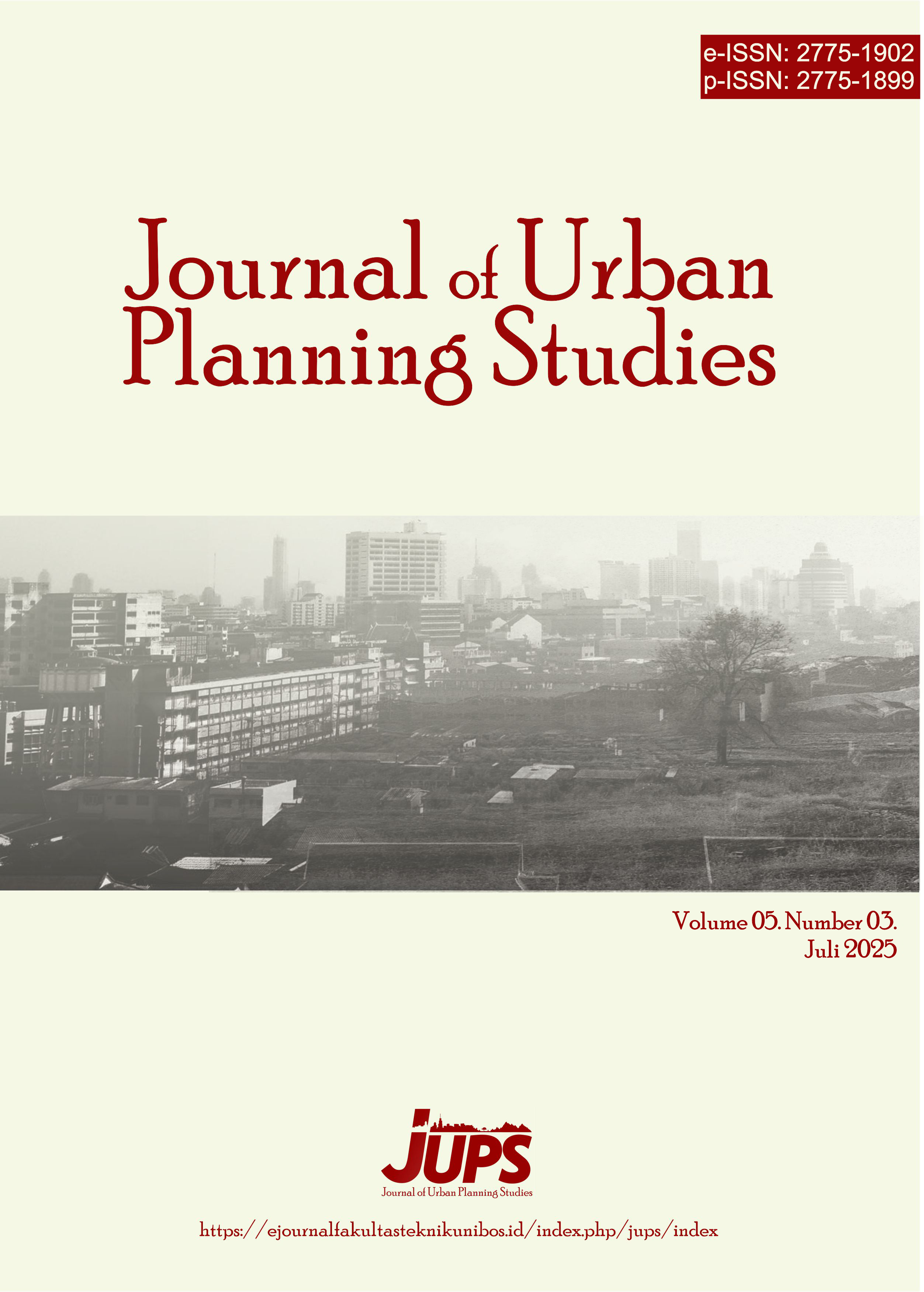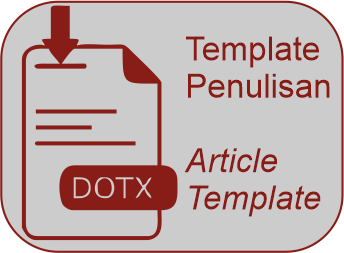Pengaruh Kawasan Berorientasi Transit terhadap Gentrifikasi Sosial Ekonomi: Studi Kasus Kawasan Stasiun Manggarai
DOI:
https://doi.org/10.35965/jups.v5i3.848Kata Kunci:
gentrifikasi, kawasan berorientasi transit, sosial ekonomi, kawasan stasiun manggaraiAbstrak
Abstract. Transit-oriented development (TOD) integrates transportation and land use with high density and mixed functions. However, the development of these areas has the potential to trigger gentrification, as happened in Manggarai, Jakarta, where land prices increased after TOD development. This study aims to analyze the influence of TOD elements on socioeconomic gentrification around Manggarai Station. The method used is multivariate regression analysis based on observations, documentation, and literature from government agencies. The results show that land use area influences population size, particularly through the conversion of vacant land into residential or commercial use. However, socioeconomic variables such as education level, occupation type, income, and land prices are not significantly affected by land area, commercial density, or pedestrian length. Conversely, distance from the station significantly affects population size, education level, and land prices. Areas closer to the station are more desirable due to transportation accessibility, although this does not have a major impact on inbound migration or income. These findings emphasize the importance of policies that consider the socioeconomic impacts of TOD development.
Abstrak. Kawasan berorientasi transit (TOD) mengintegrasikan transportasi dan penggunaan lahan dengan karakteristik kepadatan tinggi dan fungsi campuran. Namun, pengembangan kawasan ini berpotensi memicu gentrifikasi, seperti yang terjadi di Manggarai, Jakarta, di mana harga lahan meningkat pasca-pengembangan TOD. Penelitian ini bertujuan menganalisis pengaruh elemen-elemen TOD terhadap gentrifikasi sosial ekonomi di sekitar Stasiun Manggarai. Metode yang digunakan adalah analisis regresi multivariat berdasarkan observasi, dokumentasi, dan literatur dari instansi pemerintah. Hasil menunjukkan bahwa luas penggunaan lahan berpengaruh terhadap jumlah penduduk, terutama melalui alih fungsi lahan kosong menjadi perumahan atau perkantoran. Namun, variabel sosial ekonomi seperti tingkat pendidikan, jenis pekerjaan, pendapatan, dan harga lahan tidak terpengaruh secara signifikan oleh luas lahan, kepadatan komersial, maupun panjang pedestrian. Sebaliknya, jarak dari stasiun berpengaruh signifikan terhadap jumlah penduduk, tingkat pendidikan, dan harga lahan. Area yang lebih dekat ke stasiun lebih diminati karena aksesibilitas transportasi, meskipun tidak berdampak besar pada migrasi masuk atau pendapatan. Temuan ini menekankan pentingnya kebijakan yang memperhatikan dampak sosial ekonomi dari pengembangan TOD.
Referensi
Aditantri, R., Rahmi, L. A., Kusumodewi, A. N., & Wibisono, A. D. (2023). Growth Centre Interaction Through Gravity Model Approach Using Geographic Information System. IOP Conference Series: Earth And Environmental Science, 1264(1). Institute Of Physics. Https://Doi.Org/10.1088/1755-1315/1264/1/012019
Ariani, N. M., Priambudi, B. N., & Wijaya, M. I. H. (2022). Land Use Change As One Of The Indicators To Formulate The Gentrification Phase At The Diponegoro University Semarang. IOP Conference Series: Earth And Environmental Science, 1089(1). Institute Of Physics. Https://Doi.Org/10.1088/1755-1315/1089/1/012040
Chen, Y., Xi, H., & Jiao, J. (2023a). What Are The Relationships Between Public Transit And Gentrification Progress? An Empirical Study In The New York–Northern New Jersey–Long Island Areas. Land, 12(2). Https://Doi.Org/10.3390/Land12020358
Cherednichenko, O. (2022). Developing Of Indicators For Assessing The Level Of Development Of City Transport Systems.Публічне Адміністрування Та Національна Безпека. Https://Doi.Org/10.25313/2617-572x-2022-5-8181
Cocola-Gant, A. (2015). Tourism And Commercial Gentrification. RC21 International Conference. “The Ideal City: Between Myth And Reality. Representations, Policies, Contradictions And Challenges For Tomorrow’s Urban Life.” Urbino. Retrieved From Http://Www.Rc21.Org/En/Conferences/Urbino2015/
Deka, D. (2017). Benchmarking Gentrification Near Commuter Rail Stations In New Jersey. Source: Urban Studies, 54(13), 2955–2972. Https://Doi.Org/10.2307/26428363
Erragcha, N., & Babay, H. (2022). Effects Of Media Coverage And Perceived Risk During COVID-19: Moderated Mediation Model.African Journal Of Hospitality, Tourism And Leisure. Https://Doi.Org/10.46222/Ajhtl.19770720.327
Fernando, M., Heinen, E., & Johnson, D. (2021). Exposure, Timing, And Vulnerability: The Role Of Public Transport In Inducing Gentrification.Journal Of Transport And Land Use. Https://Doi.Org/10.5198/JTLU.2021.1897
Ghozali, I. (2018). Aplikasi Analisis Multivariate Dengan Program IBM SPSS 25 (9th Ed.). Semarang: Badan Penerbit Universitas Diponegoro.
González, S. R., Loukaitou-Sideris, A., & Chapple, K. (2019). Transit Neighborhoods, Commercial Gentrification, And Traffic Crashes: Exploring The Linkages In Los Angeles And The Bay Area. Journal Of Transport Geography, 77, 79–89. Https://Doi.Org/Https://Doi.Org/10.1016/J.Jtrangeo.2019.04.010
Hidayati, I. (2020). Understanding Mobility Inequality: A Socio-Spatial Approach To Analyse Transport And Land Use In Southeast Asian Metropolitan Cities. Https://Doi.Org/10.33612/DISS.146785021
Lee, J. H. (2020). Reflecting On An Integrated Approach For Transport And Spatial Planning As A Pathway To Sustainable Urbanization.Sustainability. Https://Doi.Org/10.3390/SU122310218
Lee, J., Choi, K., & Leem, Y. (2016). Bicycle-Based Transit-Oriented Development As An Alternative To Overcome The Criticisms Of The Conventional Transit-Oriented Development. International Journal Of Sustainable Transportation, 10(10), 975–984. Https://Doi.Org/10.1080/15568318.2014.923547
Lees, L., Slater, T., & Wyly, E. (2013). Gentrification. In Gentrification. Taylor And Francis. Https://Doi.Org/10.4324/9780203940877
Li, Z., Cao, C., & Deng, X. (2022). Research On The Regional Development And Transformation In Development Geography.FRONTIERS OF DEVELOPMENT GEOGRAPHY. Https://Doi.Org/10.48014/Fdg.20220618001
Lieske, S. N., Van Den Nouwelant, R., Han, J. H., & Pettit, C. (2021). A Novel Hedonic Price Modelling Approach For Estimating The Impact Of Transportation Infrastructure On Property Prices.Urban Studies. Https://Doi.Org/10.1177/0042098019879382
Lisa Wahyulina, B., & Ellisa, E. (2020). The Potential Of Transit-Oriented Development (TOD) And Its Typology In Block-A Area.
Lutz, E., Wicki, M., & Kaufmann, D. (2024). Creating Inequality In Access To Public Transit? Densification, Gentrification, And Displacement. Environment And Planning B: Urban Analytics And City Science. Https://Doi.Org/10.1177/23998083241242883
Mcdougall, E., Webber, K., & Petrie, S. (2023). Addressing The Need For More Nuanced Approaches Towards Transit‐Induced Gentrification: A Case For A Complex Systems Thinking Framework.Geography Compass. Https://Doi.Org/10.1111/Gec3.12681
Medha, A. N. (Azka), & Ariastita, P. G. (Putu). (2017). Pandangan Terhadap Fenomena Gentrifikasi Dan Hubungannya Dengan Perencanaan Spasial. Jurnal Teknik ITS, 6(2). Https://Doi.Org/10.12962/J23373539.V6I2.25056
Medha, A. N., & Ariastita, P. G. (2017). Pandangan Terhadap Fenomena Gentrifikasi Dan Hubungannya Dengan Perencanaan Spasial. Jurnal Teknik ITS, 6(2), C202–C205. Https://Doi.Org/10.12962/J23373539.V6I2.25056
Mirzazadeh, B. (2023). The Impact Of Socio-Economic, Land Use, And Travel Related Variables On Escort And Non-Escort Intermediate Stops On Work Tours. Current Urban Studies, 11(01), 43–59. Https://Doi.Org/10.4236/Cus.2023.111003
Nunez, R. (2022).The Geography Of Gentrification. Https://Doi.Org/10.4324/9781003341239-15
Padeiro, M., Louro, A., & Da Costa, N. M. (2019). Transit-Oriented Development And Gentrification: A Systematic Review. Transport Reviews, 39(6), 733–754. Https://Doi.Org/10.1080/01441647.2019.1649316
Peraturan Daerah DKI Jakarta Nomor 1. (2012). Tentang Rencana Tata Ruang Wilayah 2030.
Permen ATR/Kepala BPN No. 16. (2017). Pedoman Pengembangan Kawasan Berorientasi Transit.
Shi, J., Duan, K., Xu, Q., & Li, J. (2021). Effect Analysis Of The Driving Factors Of Super-Gentrification Using Structural Equation Modeling.PLOS ONE. Https://Doi.Org/10.1371/JOURNAL.PONE.0248265
Silva, C. A., Giannotti, M. A., & De Almeida, C. M. (2020). Dynamic Modeling To Support An Integrated Analysis Among Land Use Change, Accessibility And Gentrification.Land Use Policy. Https://Doi.Org/10.1016/J.LANDUSEPOL.2020.104992
Thomas, R., & Bertolini, L. (2017). Defining Critical Success Factors In TOD Implementation Using Rough Set Analysis. Journal Of Transport And Land Use, 10(1), 139–154. Https://Doi.Org/10.5198/JTLU.2015.513
United Nations. (2018). World Urbanization Prospects 2018 Highlights.
Vardopoulos, I., Maialetti, M., Scarpitta, D., & Salvati, L. (2024). Spatially Explicit Analysis Of Landscape Structures, Urban Growth, And Economic Dynamics In Metropolitan Regions. Urban Science, 8(4). Https://Doi.Org/10.3390/Urbansci8040150
Vega, J., Balcázar, R., & Guerra, X. (2023). Transportation Oriented Development Method: Literature Review. IOP Conference Series: Earth And Environmental Science, 1141(1). Https://Doi.Org/10.1088/1755-1315/1141/1/012002
Wang, Y., & Wang, X. (2021, April 8).The Changes And System Construction Of Spatial Planning From The Perspective Of Policy Diffusion. Https://Doi.Org/10.2991/ASSEHR.K.210407.014
##submission.downloads##
Diterbitkan
Cara Mengutip
Terbitan
Bagian
Lisensi
Hak Cipta (c) 2025 Permata Dwi Wulandari, Rahmatyas Aditantri

Artikel ini berlisensi Creative Commons Attribution 4.0 International License.













